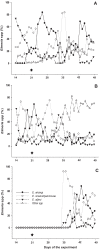Immunoprotection against mixed Eimeria spp. infections in goat kids induced by X-irradiated oocysts
- PMID: 35238997
- PMCID: PMC8993715
- DOI: 10.1007/s00436-022-07465-z
Immunoprotection against mixed Eimeria spp. infections in goat kids induced by X-irradiated oocysts
Abstract
Strategies to control goat coccidiosis traditionally rely on the use of management practices combined with anticoccidial treatments, and limited effort has been made, so far, to address immunological control of caprine Eimeria infections. Previously, we showed that monospecific immunization with X-Rad-attenuated Eimeria ninakohlyakimovae oocysts induced considerable immunoprotection upon challenge. In the present study, we conducted a similar vaccination trial but using a mixture of caprine Eimeria species typically present in natural infected goats. For immunization, sporulated oocysts were attenuated by X irradiation (20 kilorad). All infections were performed orally applying 105 sporulated oocysts of mixed Eimeria spp. per animal. In total, 18 goat kids were grouped as follows: (G1) immunized + challenge infected; (G2) primary + challenge infected; (G3) challenge infection control; and (G4) non-immunized/non-infected control. Overall, goat kids infected with attenuated oocysts (= immunized) shed less oocysts in the faeces and showed a lower degree of clinical coccidiosis than animals infected with non-attenuated oocysts. Animals of both challenge groups (G1 and G2) showed partial immunoprotection upon reinfection when compared to challenge infection control (G3). However, the degree of immunoprotection was less pronounced than recently reported for monospecific vaccination against Eimeria ninakohlyakimovae, most probably due to the complexity of the pathogenesis and related immune responses against mixed Eimeria spp. infections. Nevertheless, the data of the present study demonstrate that immunization with attenuated Eimeria spp. oocysts may be worth pursuing as a strategy to control goat coccidiosis.
Keywords: Eimeria spp.; Goats; Immunoprotection; Vaccine; X-Rad attenuation.
© 2022. The Author(s).
Conflict of interest statement
The authors declare no competing interests.
Figures




References
-
- Balicka-Ramisz A, Ramisz A, Vovk S, Snitynskyj V. Prevalence of coccidia infection in goats in Western Pomerania (Poland) and West Ukraine region. Ann Parasitol. 2012;58:167–171. - PubMed
Publication types
MeSH terms
Grants and funding
LinkOut - more resources
Full Text Sources
Miscellaneous

